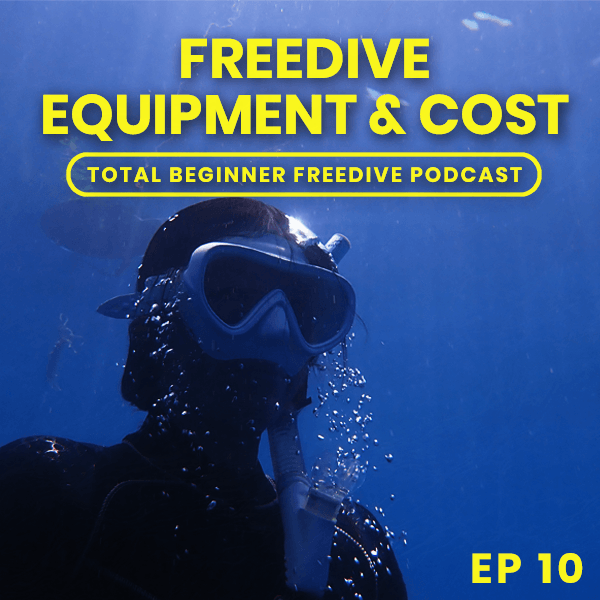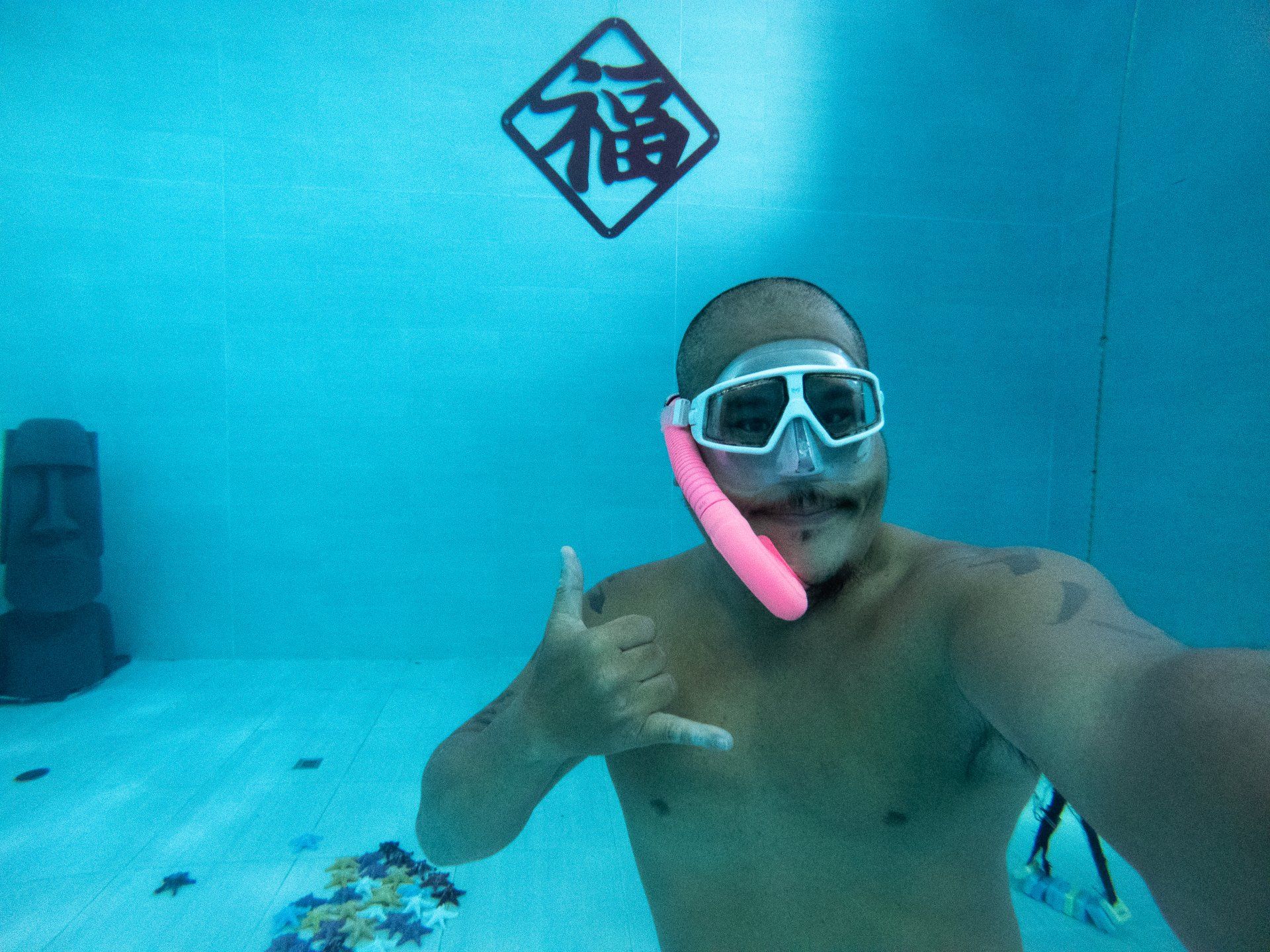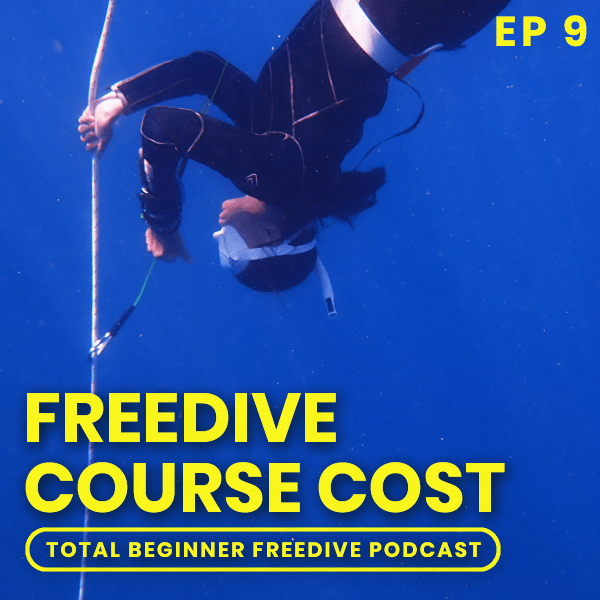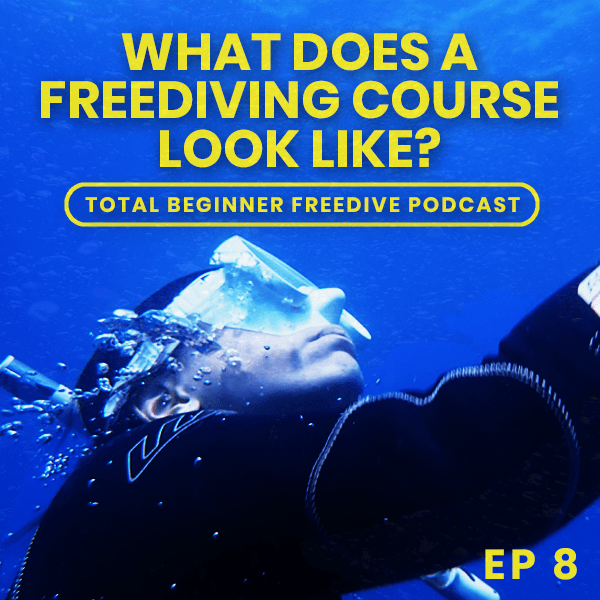Raymond Ko • August 24, 2021
Freediving Equipment & Costs

Show Notes
This episode is a quick primer on what freediving equipment you'll need for a beginner freedive course, whether to rent or buy and general cost for each piece of equipment.
This podcast is brought to you by Octopus Freediving
Resources
How to check freedive mask fits> - Youtube Video
Facebook Group
Free Beginner FAQ E-book Sign Up
Free Online Freedive Safety Course
Send episode topic ideas or questions to ray@freedivenomad.com
Show us some love by buying from our affiliates partners:
Synctuition - my favorite meditation app and I've tried A LOT
Blue Cannatine - the BEST nootropic to get my brain to function optimally after diving. 10% discount with that link
Waihana Wetsuits - the coolest looking wetsuits using eco-friendly neoprene. Use the coupon code 0OG0UZZBLP for 15% off
Book Online Course - Beginner online theory course for Molchanvos. Includes 1.5 hours online, manual, online test and certification fees.
You Can Find Me At
Freedive Nomad Instagram Account
Freedive Nomad Facebook Group
Freedive Nomad Youtube Channel
Podcast Media Kit
Transcripts
Hello future freedivers,
And thank you for downloading this episode of the Total Beginner Freedive Podcast brought to you by Octopus freediving.
This is episode #10 about what equipment you’ll need as a beginner or for your beginner course and general cost. In the next episode I will go into more details on fins and wetsuits. Jingle please.
Hello again, Ray here aka the Freedive Nomad and the host of this show.
When I first got into freediving, I thought it was going to be a lot cheaper hobby vs scuba diving as freediving doesn’t have as much equipment. Boy was I seriously wrong.
I just saw a meme on Facebook that said “Steal a man’s wallet and he’ll be poor for a week. Teach him to dive, he’ll be poor for the rest of his life”, and that is true for both scuba diving and freediving.
Don’t get me wrong though, freediving can be as cheap as the price of mask if you are diving in warm waters but it can also get really expensive.
If you buy all your equipment at the lower end of the price range you are still looking at at least a few hundred US$. Great budget places to buy your equipment are Decathlon which make high quality entry level equipment for any sport including freediving or Amazon which quality can be a bit of a hit and miss but at least you can return it
So let’s go over the basics first -
As a beginner student at a minimum you will need a mask, snorkel, fins, wetsuit, weights and weight belt and a wetsuit.
Mask - These can go anywhere from 15-50 US$ or more. If you have a mask and snorkel from scuba, I would use those as some of my students have done before. This is something I’d also consider buying because it's generally not that expensive.
Freedive masks are lower volume, as you need to release some air into the mask from your lungs to prevent the mask from squeezing on your face too hard from the increasing hydrostatic pressure. And they come with either plastic lenses or tempered glass lenses. Plastic ones are easier to scratch but harder to break. Glass doesn't scratch as easily but can shatter if you drop it. I personally prefer plastic because they come in a curved lens which is slicker and less boxy feeling vs glass lens.
I’ve seen on some FB groups and online forums people often ask which masks are the best. And the answer to that is different for everyone as it really depends on how the mask fits on your face. I have a $15 mask I bought off Amazon that fits better than a $50 branded mask.
To see if a mask will fit you correctly, pull the straps over to the front of the mask, look towards the sky and place the mask over your eyes, then you want to feel if there is any space between the edge of the silicon skirt of the mask and your face. If there is, that mask is not right for you and try another one. Do not suck in through your nose as most people do.
If you need more of a visual on this, check out my instructor trainer video on it in the show notes.
https://www.youtube.com/watch?v=j_GgeX4V2Xc
The
Aqualung Sphera mask seems to be the most popular mask out there and I’ve heard some people say that it fits 80% of people’s faces, and unfortunately, mine is not one of them. Personally I have found the
Molchanovs Core Freediving Mask fits my flat and wide face perfectly (use coupon code FREEDIVENOMAD to get 10% off your order)
Snorkel - Again you can use your scuba one if you’d like. Get the most basic uncomplicated J shaped snorkel. You don’t want that fancy stuff on there like the splash guard which may cause you to breathe more carbon dioxide or the purge valve as those leak, break easily and you can have that flapping in your face as you descend or ascend on your dives. You can get a snorkel for US$15-30.
Fins
- the beautiful long fins are the hallmark of freediving and is one of the more costlier pieces of equipment.
An entry level pair of fins are about $100 which are plastic. If you can afford to pay a bit more, I’d go for fibreglass which probably has the best price to performance ratio but there are plenty of advanced divers taking plastic fins deep.
On the top end you have carbon fins which can set you back $500 which you honestly don’t need. If you buy carbon or fibreglass fins you have a choice of stiffness of the blades, either soft, medium or stiff. Get the soft stiffness is all you need if you have good technique and it'll save your legs.
If you have closed pocket short fins from scuba diving or your snorkelling then you can use this for your beginner freedive course, I’ve had students use these. Do not use the ones with the adjustable strap as you won’t have much power transferred into your fins as they are not designed for freediving kicking
Tune into the next episode where I will talk about the best fin option I feel for beginner freedivers.
Wetsuit - as I’ve said in a previous episode this is the one piece of equipment that I advise my students to consider buying as everyone pees in their wetsuit and it can be kinda gross no matter how well it's cleaned.
Some locations you may not even need a wetsuit if the waters are warm enough but i’d cover up with a rashguard as you never know when jellyfish are out to bite you. Also, even if you are in warm water because the thermal conductivity of water is 20x that of air, even water a few degrees below your body temperature is enough to make you feel cold, so layer up.
If you already have a wetsuit from scuba or surfing, I’d check with your instructor if you could use that. No reason to buy a new one. I used my scuba wetsuit for for awhile until I got my specialized freedive wetsuit.
We’ll get into more detail about wetsuits in the next episode.
Weight belt and weights
Freedive weight belts should be rubber and here is why, as you dive deeper, your body will shrink due to hydrostatic pressure. If you use a regular scuba nylon belt, then as you shrink, your weight belt will loosen and fall down to your armpits. With a rubber belt, as you shrink, the rubber belt will continue to cinch onto your waist staying in place instead of awkwardly in your armpits.
Unfortunately, these rubber weight belts cost around US$20-30 pretty expensive considering how basic of a product it is, like the snorkel.
For weights, the starting point is the thickness of your wetsuit plus 2kgs. So if you have a 5mm wetsuit, then you want to start with 7kgs. Note, that everyone’s body composition is different and the range of weights you will need to wear will vary widely.
And the first thing you will do at the start of an open water session is your instructor will check to see if you are properly weighted.
I would check with your school or instructor if they provide weights, most schools that have students who fly in would have weights you can use as it can get pretty expensive to fly with them.
So those are the most basic equipment you will need - depending on temperature of the waters you dive in you may need neoprene boots or gloves to help you keep warm.
Just a quick bit on choosing the color of your equipment. As you go freediving in bigger groups or you go to a school or go boat diving there’s going to be a lot of equipment that are the same color and look alike. Most of the equipment is black so if I have a choice to pick a color other than black, I would do so. Also, mark your equipment, I use a permanent pen to mark my fins, snorkel and mask or you can wrap some colorful electrical tape around your snorkel, it will also help your safety spot you in low visibility waters. So if you ever see my Instragram, that’s why I have a lot of hot pink equipment. Easier to find, harder to lose, easier to be spotted in the water and I just like that color.
To try to find used equipment, look for a Facebook group in your local area for freediving and post on there, I started one in Las Vegas, I’ve seen groups for Southern California, here in Taiwan, Bali, Austin, Texas etc. etc.
Check if there is a scuba or spearfishing shop near you that rents equipment, some have programs where you can use your rental costs as store credit to buy your equipment from them.
And that’s it for today’s show.
If you’ve found this podcast really helpful and want some way to support it you can either leave me a review on the Apple podcast platform or buy me a coffee at freedivepodcast.com/coffee.
That’s it,
Dive safe and never dive alone!





